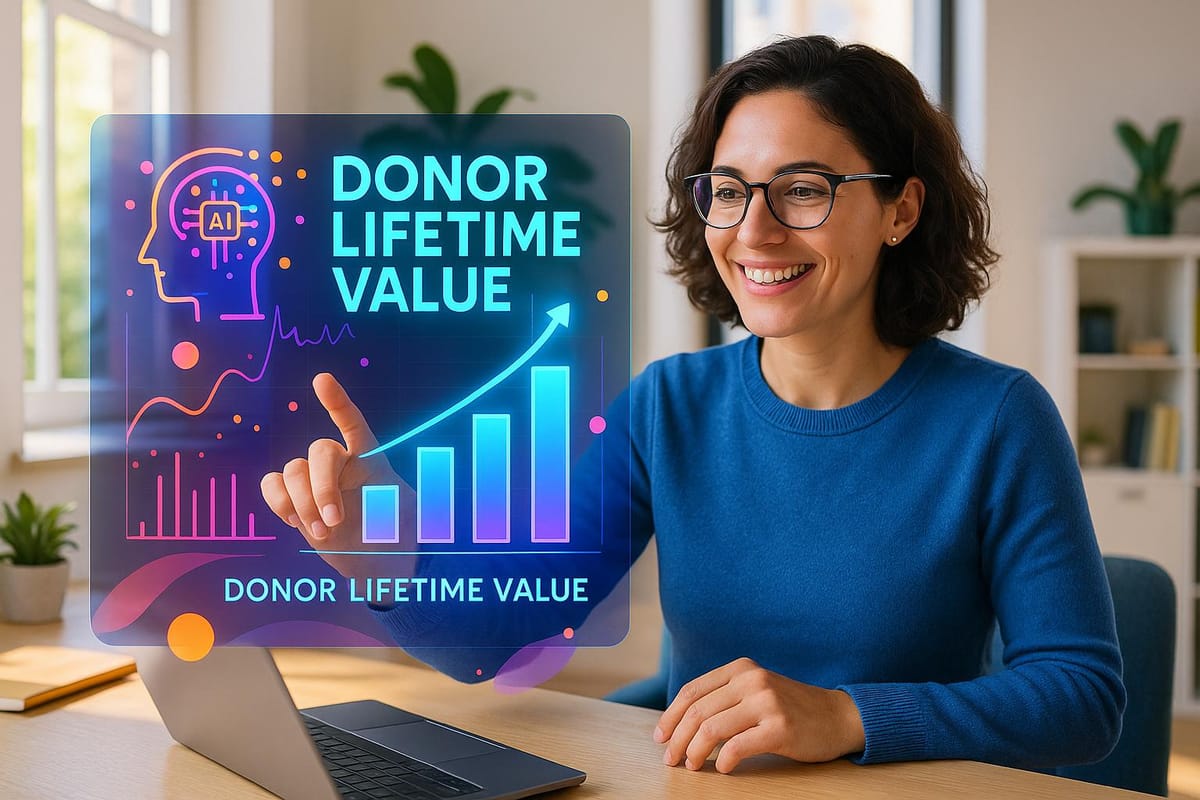Using AI and Donor Lifetime Value for Fundraising
Discover how AI and donor lifetime value analysis can transform your fundraising strategies, improve engagement, and maximize donor contributions.

In the ever-evolving landscape of nonprofit fundraising, staying ahead requires not just passion but also strategic innovation. Donor Lifetime Value (DLV), a concept borrowed and adapted from the for-profit sector, is emerging as a transformative tool for nonprofits, especially those focused on child sponsorship programs, donor engagement, and financial sustainability. By leveraging predictive analytics, artificial intelligence (AI), and behavioral data, nonprofits can unlock actionable insights to boost donor engagement, maximize returns, and ensure long-term impact.
This article explores key insights, strategies, and applications from a panel discussion featuring nonprofit experts Greg Hagin, Ashutosh Nandeshwar, and Peter Fader. Together, they unpacked the immense potential of DLV to reshape fundraising strategies and donor engagement in today’s complex philanthropic environment.
Understanding Donor Lifetime Value (DLV)
At its core, Donor Lifetime Value (DLV) is the projected value a donor will contribute to an organization over their relationship lifetime. It’s a predictive metric that combines three key donor behaviors:
- Retention: How long a donor remains engaged and continues giving.
- Frequency: How often a donor contributes.
- Monetary Value: How much the donor gives with each contribution.
DLV bridges the gap between financial accountability and donor-centric strategies. By understanding and quantifying long-term donor value, nonprofits can make data-driven decisions about resource allocation, engagement strategies, and donor retention efforts.
"DLV is not just a metric - it’s a decision-making framework", emphasized Peter Fader, a renowned expert on customer analytics. "It allows nonprofits to focus on the donors who provide the highest return on investment and ensure resources are allocated effectively."
Why DLV Matters in Nonprofit Fundraising
Nonprofits are no strangers to the challenges of limited resources, donor fatigue, and increasing competition for funding. Traditional approaches to fundraising often focus on short-term results, neglecting the long-term value of donor relationships. DLV offers several advantages that make it a game-changer for fundraising:
- Improved ROI: DLV helps nonprofits identify high-value donors and prioritize investments that yield the best long-term returns.
- Personalized Engagement: Predicting donor behavior enables targeted messaging and tailored campaigns, fostering deeper connections.
- Resource Efficiency: By focusing on retention, upgrades, and strategic acquisition, nonprofits can maximize their impact with limited budgets.
- Risk Management: Quantifying donor behavior allows nonprofits to measure the variability and risk of future contributions, leading to more informed strategies.
Applying DLV: Key Use Cases for Nonprofits
1. Enhancing Donor Retention
Retention is a critical component of DLV. Research highlighted during the discussion revealed a staggering insight: 50% of top donors stop giving within six years. This underscores the importance of proactive engagement and stewardship to ensure donors remain committed.
Practical Steps:
- Use predictive analytics to identify at-risk donors and intervene with personalized outreach.
- Focus on the first three years of a donor relationship when engagement potential is highest.
- Employ AI-powered tools to analyze donor behavior and recommend tailored engagement strategies.
2. Strategic Donor Acquisition
Acquiring new donors is often costly and resource-intensive. However, by leveraging DLV, nonprofits can adopt lookalike modeling to target prospects who resemble high-value donors. This ensures acquisition efforts are focused on individuals with the highest potential lifetime value.
Practical Steps:
- Analyze behavioral traits (e.g., donation patterns, event attendance) of top donors.
- Develop campaigns that resonate with high-value donor segments.
- Avoid over-reliance on demographic data, focusing instead on actionable behavioral indicators.
3. Donor Upgrades and Stewardship
DLV empowers nonprofits to identify donors who are ready to upgrade their giving contributions. By understanding donor journeys, organizations can create pathways for small or mid-size donors to grow into major contributors.
Practical Steps:
- Segment donors based on their capacity and likelihood to upgrade.
- Design targeted campaigns to encourage sustained giving or multi-year pledges.
- Highlight measurable impact and outcomes to bolster trust and commitment.
4. Measuring Engagement ROI
Stewardship activities such as events, mailings, or volunteer opportunities are essential, but their impact is often hard to quantify. DLV provides a neutral framework to evaluate the ROI of such activities, ensuring that resources are allocated to initiatives with high returns.
Practical Steps:
- Compare donor engagement strategies using DLV metrics to identify high-performing activities.
- Conduct experiments to refine messaging and engagement formats.
- Leverage AI to automate insights and streamline decision-making.
5. Portfolio Optimization for Gift Officers
For nonprofits with dedicated fundraising teams, DLV can guide portfolio management by helping gift officers focus on high-potential prospects. This ensures efforts are aligned with organizational priorities and donor potential.
Practical Steps:
- Assign gift officers portfolios based on DLV scores.
- Use predictive models to identify donors likely to convert into major contributors.
- Regularly reassess portfolios to incorporate new data and insights.
DLV and the Role of Technology
Artificial intelligence (AI) and machine learning are revolutionizing how nonprofits approach DLV. By integrating these technologies, organizations can analyze vast datasets, uncover patterns, and automate analytics for quicker decision-making. Additionally, AI enables scalable personalization, achieving authentic donor engagement across large populations.
Potential Applications:
- Predictive Modeling: Forecast donor behavior and fundraising outcomes using statistical simulations like Monte Carlo analysis.
- Engagement Strategies: Tailor messaging and campaigns using AI-powered insights.
- Automation: Streamline donor segmentation, event planning, and follow-ups to maximize efficiency.
"AI doesn’t replace authenticity; it enhances it by enabling nonprofits to connect with donors in meaningful and personalized ways", noted Ashutosh Nandeshwar, a leading expert on data science for fundraising.
Overcoming Challenges: Balancing Automation and Authenticity
One of the key concerns raised during the discussion was the tension between automation and authenticity. Nonprofits must balance the efficiency of AI-driven engagement with the need for genuine, human-centered relationships. Stakeholders should adopt a thoughtful approach, ensuring that technology supports - not replaces - their mission-driven work.
Key Takeaways
- DLV Is Transformative: By quantifying the lifetime value of donors, nonprofits can make more strategic and data-informed decisions.
- Focus on Retention and Upgrades: Retaining and upgrading donors is often more cost-effective and impactful than acquiring new ones.
- Start Small, Scale Strategically: Begin with pilot projects or focused campaigns to test and refine DLV methodologies.
- Leverage AI for Insights: Use AI and predictive analytics to identify high-value donors, measure ROI, and personalize engagement at scale.
- Evaluate Risks: Incorporate risk analysis into DLV calculations to understand variability and manage uncertainty.
- Invest in Acquisition Thoughtfully: Target donors with high potential using lookalike models and behavioral insights.
- Stewardship Matters: Ongoing engagement and authentic communication are critical for fostering long-term donor relationships.
- Optimize Portfolios: Use DLV scores to guide gift officer strategies and maximize major gift opportunities.
Conclusion
The nonprofit sector is at a pivotal moment, with data and technology providing unprecedented opportunities to drive impact and efficiency. Donor Lifetime Value (DLV) is more than a metric - it’s a framework for sustainable growth and meaningful engagement. By embracing DLV, nonprofits can align their strategies with donor behavior, maximize their resources, and secure a brighter future for their missions.
As nonprofit professionals, the time to act is now. Start small, experiment boldly, and let data guide your journey toward transformative fundraising success. The insights you uncover today will shape the impact you create for years to come.
Source: "How Top Nonprofits Use Al And Donor Lifetime Value For Fundraising Success" - CCS Fundraising, YouTube, Sep 5, 2025 - https://www.youtube.com/watch?v=XTz7exo7c58
Use: Embedded for reference. Brief quotes used for commentary/review.

